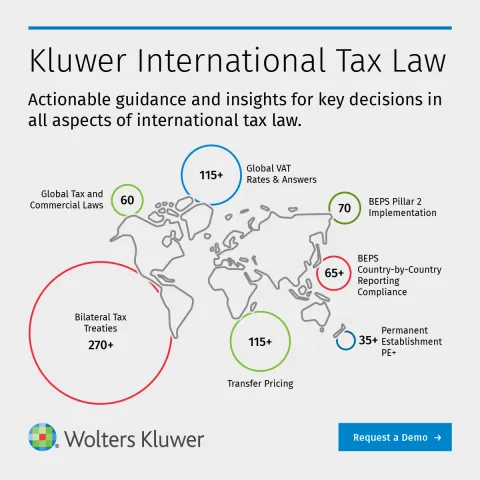Tax incentives everywhere: what will come of it?
September 15, 2025
1. Introduction
Earlier this year, the 2024 update of the OECD Investment Tax Incentives Database (ITID) was published.2 The ITID provides useful information on the design, eligibility and governance of corporate income tax (CIT) incentives related to investment across 70 economies – mostly emerging and developing. For 52 economies that were also part of the 2022 edition, the ITID provides insights into the evolution of CIT incentives over the period 2022-2024.
The report concludes that “tax incentives remain a popular tool among governments for promoting investment, despite potential uncertainties about their effectiveness” and that “[o]ver the two-year period, the use of investment tax incentives by the 52 economies has risen”.3 In this context, the ITID’s executive summary, inter alia, emphasizes that the “widespread reliance on income-based instruments across economies is concerning”, that “[t]ax exemptions typically are generous” and that the “governance of investment tax incentives is complex”.4
In this blog, I will argue that the (in my view) somewhat critical tone towards the ITID’s covered economies’ tax incentive policies is surprising, especially in light of recent developments around the global minimum tax (Pillar Two) and the position of tax incentives under that system.
2. General remarks on the ITID, Pillar Two and tax incentives
Most of the economies covered by the 2024 ITID update qualify as low or middle income economies.5 It should be noted that a significant number of the covered economies are part of the Inclusive Framework on Base Erosion and Profit Shifting (IF) that joined the “Statement on a Two-Pillar Solution to Address the Tax Challenges Arising from the Digitalisation of the Economy” of October 2021.6 As regards the second pillar (Pillar Two), the so-called Global Anti-Base Erosion (GloBE) rules are intended to ensure large multinational enterprises (MNEs) are taxed at a minimum level of 15% in each of the jurisdictions where they operate, and doing so by imposing a top-up tax on profits whenever the jurisdictional effective tax rate (ETR) is below 15%.7
At the same time, tax incentives usually reduce the amount of taxes paid and may have a downward effect on the ETR. Thus, investment tax incentives could be diminished or even entirely reversed as a result of top-up tax under Pillar Two.8 Still, the impact of tax incentives under Pillar Two will, among other things, depend on their design.9 One of the relevant design features for Pillar Two purposes is the extent to which tax incentives are refundable. Under the GloBE rules, qualifying refundable tax credits (QRTCs) are treated as income (i.e. the denominator in the ETR computation),10 while other types of tax credits (e.g. non-qualifying refundable tax credits and non-refundable tax credits) are treated as a tax reduction (i.e. the numerator in the ETR computation).11 By treating QRTCs as income, the GloBE rules closely follow the financial accounting treatment of refundable tax credits.12 Generally speaking, the downward effect on the ETR will be less substantial in the case of QRTCs compared to other tax credits. Therefore, when reconsidering tax incentive design from a Pillar Two perspective, QRTCs could form the preferred policy option.13
3. Administrative Guidance of January 2025
The January 2025 Administrative Guidance (AG), as approved by the IF and prepared for publication by the OECD Secretariat, addresses the treatment of certain deferred tax assets under Article 9.1 of the GloBE Rules. The latter provision constitutes simplified transition rules and allows MNEs to take into account certain deferred tax accounting attributes that arose prior to the first year in which the GloBE Rules entered into effect (the Transition Year).14 This is of importance, as the GloBE rules include (adjusted) deferred tax accounting attributes (the “Total Deferred Tax Adjustment Amount”) in the computation of the “Adjusted Covered Taxes” (ACT) (i.e. taxes to be taken into account in the ETR computation).15 In short, a deferred tax liability (DTL) accrual increases the ACT, whereas a deferred tax asset (DTA) accrual decreases the ACT, with the reversal of the DTL or DTA causing the opposite effect on the ACT.
The AG stresses that “the Article 9.1 transition rules are not intended to serve as a mechanism that MNE Groups or General Governments can use to engage in transactions or provide tax attributes that produce deferred tax assets that when reversed will effectively shelter all or a portion of an MNE Group’s future low-taxed income from the GloBE Rules”. In summary, the AG further stipulates that some central governments, probably those of high income economies,16 have granted tax benefits – such as tax credits and tax reliefs – to MNEs in advance of the global minimum tax coming into effect. MNEs have recorded these benefits as DTAs in the financial accounts with the potential of taking them into account under Article 9.1.17 Since this was considered an undesirable outcome, it was decided to inter alia exclude DTAs attributable to governmental arrangements (if concluded or amended after 30 November 2021) from the application of Article 9.1 and the transitional CbCR safe harbour rule.
Having said that, the AG still allows a portion of the deferred tax expenses attributable to the reversal of the aforementioned DTAs (i.e. causing an ACT increase) to be taken into account during a “Grace Period” of around two years.18 The AG stresses that the aforementioned tax benefits would constitute benefits provided in relation to the GloBE rules (i.e. “related benefits”) that would in principle prevent a domestic minimum top-up tax (DMTT) and a DMTT safe harbour rule from obtaining a qualifying (QDMTT) status under the transitional qualification mechanism. Nevertheless, an “exceptional derogation” was agreed that still allows central governments to self-certify for a transitional qualified status.19
4. Summarizing and concluding observations
So where do we stand? On the one hand, we have the 2024 ITID update making some critical comments on the (increased) use of tax incentives by emerging and developing economies. On the other hand, we have the January 2025 AG excluding DTAs attributable to tax benefits – probably those provided by high income economies’ central governments – from the application of the GloBE transition rules and the transitional CbCR safe harbour rule, while still allowing a portion of those DTAs to be taken into account. On top of that, the AG allows central governments to self-certify their DMTTs and DMTT safe harbour rules for a transitional qualified status. In my opinion, these exceptions effectively undermine the rules that were initially intended to neutralize the undesired effects of tax benefits provided in light of the global minimum tax coming into effect. Criticising certain countries for their tax incentive policies while effectively (although partly) accepting the introduction of Pillar Two-undermining tax incentives by others, feels confusing.
The OECD has previously stated that developing countries see tax incentives as an important tool for attracting foreign direct investment,20 while potential investment effects may be nullified as a result of other countries applying the global minimum tax.21 Either way, countries worldwide (including developing countries) are effectively forced to reconsider tax incentive design due to the introduction of Pillar Two. In the EU, for example, a shift from “cut rate-broaden base” tax policies to competition on base-narrowing tax policies will presumably intensify as a result of the global minimum tax. Thus, tax competition may not end altogether but persist in other forms.22 However, when thinking in terms of financial and technical capacity, it should not come as a surprise that (as far as I know) mostly high income economies have been reconsidering their tax incentive regimes, for example by introducing tax credits in the form of QRTCs.23 Moreover, the European Commission recently published its recommendations on the use of tax incentives to support the “Clean Industrial Deal”, in which it encourages Member States to explore the options of implementing refundable tax credits in line with the QRTC provisions in Council Directive (EU) 2022/2523 (the Pillar Two Directive).24 In contrast, the 2024 ITID update notes that only one out of the 48 tax credits used across the 70 (emerging and developing) economies include a refundability provision and, in addition, that the use of tax incentives in the form of tax credits seems to be positively correlated with income levels.25
One could question whether introducing a different Pillar Two treatment of refundable and non-refundable tax credits was desirable; Pillar Two should have ended the race to the bottom, but it seems that an (unequal) race for investment under Pillar 2 has only just begun. In this context, it remains to be seen what will emerge from the recent G7 statement26 on the global minimum tax regarding the proposed introduction of a “side-by-side” system with the U.S. – notably because work to deliver such a system “would be undertaken alongside considering changes to the Pillar 2 treatment of substance based non-refundable tax credits that would ensure greater alignment with the treatment of refundable tax credits”.27 I guess the treatment of tax incentives may even become more important in the Pillar Two debate. Still, I cannot help but wonder: is this the global minimum tax-world we had hoped for?
- 1Corporate income tax specialist at the Dutch Tax Administration. This blog is written in a personal capacity and reflects the personal views of the author.
- 2OECD (2025), “OECD Investment Tax Incentives Database 2024 update: Corporate income tax incentives in emerging and developing economies”, OECD Business and Finance Policy Papers, No. 79, OECD, Paris, https://www.oecd.org/en/publications/oecd-investment-tax-incentives-database-2024-update_b0de19dc-en.html.
- 3Ibid., at 24.
- 4Ibid., at 6-7.
- 5Ibid., at 28-29 and 33 (note 1). The report refers to the classification by income level as defined by the World Bank.
- 6Compare ibid., at 8 (table 1), with https://www.oecd.org/content/dam/oecd/en/topics/policy-issues/beps/oecd-g20-inclusive-framework-members-joining-statement-on-two-pillar-solution-to-address-tax-challenges-arising-from-digitalisation-october-2021.pdf.
- 7OECD (2021), Tax Challenges Arising from the Digitalisation of the Economy – Global Anti-Base Erosion Model Rules (Pillar Two): Inclusive Framework on BEPS, OECD Publishing, Paris, https://doi.org/10.1787/782bac33-en.
- 8J. H. Heckemeyer et al. (2025), Tax Incentives and Investments in the EU: Best Practices and Ways to Stimulate Private Investments and Prevent Harmful Tax Practices, Publication for the Subcommittee on Tax Matters, Policy Department of the Directorate for Economy and Growth, Directorate-General for Economy, Transformation and Industry, European Parliament, Luxembourg, 34.
- 9OECD (2022), Tax Incentives and the Global Minimum Corporate Tax: Reconsidering Tax Incentives after the GloBE Rules, OECD Publishing, Paris, https://doi.org/10.1787/25d30b96-en, 29.
- 10The same applies for certain transferable tax credits (see OECD (2023), Tax Challenges Arising from the Digitalisation of the Economy – Administrative Guidance on the Global Anti-Base Erosion Model Rules (Pillar Two), July 2023, OECD/G20 Inclusive Framework on BEPS, OECD, Paris, www.oecd.org/tax/beps/administrative-guidance-global-anti-base-erosionrules-pillar-two-july-2023.pdf, para. 2).
- 11Article 3.2.4 of the GloBE rules.
- 12Supra n. 9. See also OECD (2020), Tax Challenges Arising from Digitalisation – Report on Pillar Two Blueprint: Inclusive Framework on BEPS, OECD/G20 Base Erosion and Profit Shifting Project, OECD Publishing, Paris, https://doi.org/10.1787/abb4c3d1-en.
- 13However, as Devereux and Vella show, it may not always be in a MNE’s interest for a tax credit to be a QRTC (see M. Devereux & J. Vella, “The Impact of the Global Minimum Tax on Tax Competition”, World Tax Journal, 2023 (volume 15), no. 3, para. 4).
- 14OECD (2025), Tax Challenges Arising from the Digitalisation of the Economy – Administrative Guidance on Article 9.1 of the Global Anti-Base Erosion Model Rules, OECD/G20 Inclusive Framework on BEPS, OECD, Paris (seehttps://www.oecd.org/content/dam/oecd/en/topics/policy-sub-issues/global-minimum-tax/administrative-guidance-article-9-1-globe-rules-pillar-two-january-2025.pdf).
- 15Articles 4.1 and 4.4 of the GloBE rules.
- 16Which could, for example, be subtracted from the recently published central record of Pillar Two legislation with transitional qualified status as implemented by IF member countries (seehttps://www.oecd.org/en/topics/sub-issues/global-minimum-tax/central-record-of-legislation-with-transitional-qualified-status.html).
- 17Supra n. 13, at 6.
- 18If the arrangement was concluded or amended before 18 November 2024 (supra n. 13, at 10-11).
- 19For further comments on these developments, see M. de Wilde, “Two Pillars early ‘25: Ridiculousness”, Kluwer International Tax Blog, 3 February 2025 (https://kluwertaxblog.com/2025/02/03/two-pillars-early-25-ridiculousness/).
- 20OECD (2022), G20/OECD Roadmap on Developing Countries and International Taxation: OECD Report for the G20 Finance Ministers and Central Bank Governors, OECD Publishing, Paris, https://doi.org/10.1787/cf46900c-en, 17.
- 21See M. van ‘t Riet & A. Lejour, “Developing Countries, tax Treaty Shopping and the Global Minimum Tax”, Public Finance Review, 2025 (https://journals.sagepub.com/doi/10.1177/10911421251334849).
- 22J. Ducept, S. Godar & Q. Parrinello, “The New Face of Corporate Tax Competition”, EU Tax Observatory, 2025, 11 (https://www.taxobservatory.eu/www-site/uploads/2025/05/The-New-Face-of-Corporate-Tax-Competition.pdf).
- 23See, for example, the countries listed by V. Chand & K. Romanovska in “The Impact of Pillar Two on Corporate Tax Incentives and Incentives Post Pillar Two – The Potential Rise of Tax Credits and Subsidies”, International Tax Studies, 2023 (volume 6), no. 9. Also see L. Vella & D. Mehboob, “Tax Havens Race to Lure Companies as 15% Global Levy Looms”, Bloomberg Tax, 6 December 2023 (https://news.bloombergtax.com/daily-tax-report-international/tax-havens-race-to-lure-companies-as-15-global-levy-looms).
- 24European Commission, “Commission Recommendation of 2.7.2025 on tax incentives to support the Clean Industrial Deal and in light of the Clean Industrial Deal State aid Framework”, C(2025) 4319 final (https://eur-lex.europa.eu/legal-content/EN/TXT/?uri=OJ:L_202501307).
- 25Supra n. 1, at 11 and 13.
- 26Seehttps://home.treasury.gov/news/press-releases/sb0181.
- 27For further comments on the G7 statement and other developments, see R. Russo & N. Vernola, “The international tax landscape: Minimum Tax and Maximum Confusion”, Kluwer International Tax Blog, 5 September 2025 (https://legalblogs.wolterskluwer.com/international-tax-law-blog/the-international-tax-landscape-minimum-tax-and-maximum-confusion/).
You may also like






